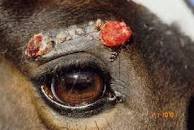Cisplatin in horse sarcoids – does perioperative timing matter?
OBJECTIVE:
To determine the benefits of reducing the interval between surgical cytoreduction and intratumoral administration of cisplatin.
DESIGN:
Randomized clinical study.
ANIMALS:
70 horses with 89 incompletely resected T2- and T3-stage sarcoids (n = 64) and squamous cell carcinomas (25).
PROCEDURE:
Horses were given 4 intratumoral treatments of cisplatin at 2-week intervals. The first treatment was given at the time of, or immediately after, surgical resection for horses treated in accordance with the perioperative protocol (group 1). Horses in group 2 were treated with cisplatin after the skin healed following surgical resection in accordance with the postoperative protocol.
RESULTS:
A difference was not found in duration of overall local tumor control between the 2 groups. Patterns of treatment failures and interval to failure differed between the 2 groups. Length of the surgical scar was the only factor that affected prognosis; an increase in length was associated with a poorer prognosis. A detrimental effect of postoperative treatment was only found in tumors with a high tumor proliferative fraction. Local reactions were similar for the 2 treatment groups, and chronic reactions were not observed.
CONCLUSIONS AND CLINICAL RELEVANCE:
Intratumoral administration of cisplatin is beneficial for treatment of cutaneous tumors in horses. Tumor repopulation during the interval between surgery and intratumoral administration of cisplatin decreases treatment efficacy. These results provide evidence of rapid tumor repopulation following surgical resection without a lag period for tumors with a high proliferation index. When tumor proliferation index is not known, it may be prudent to use the perioperative protocol.
Click here to be directed to the study.

